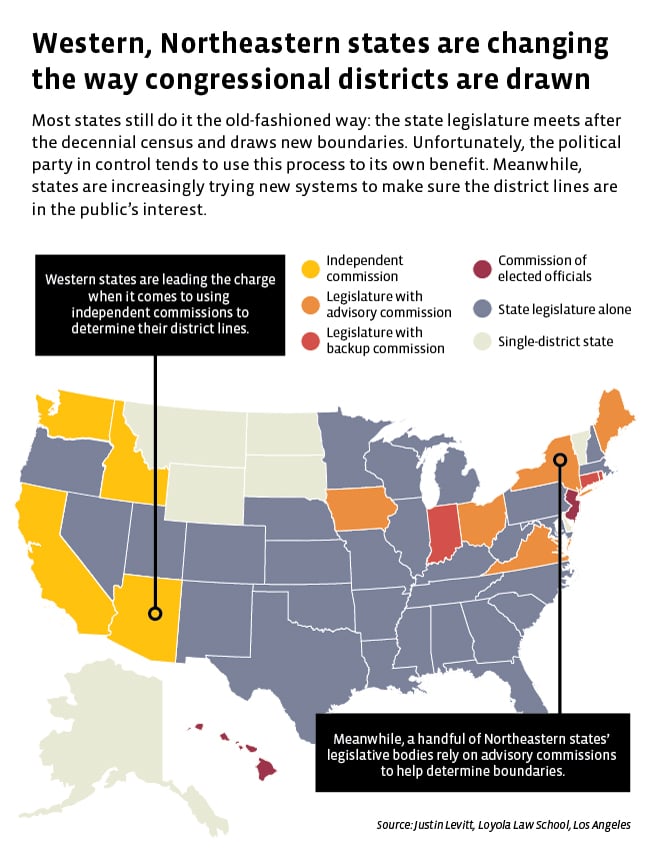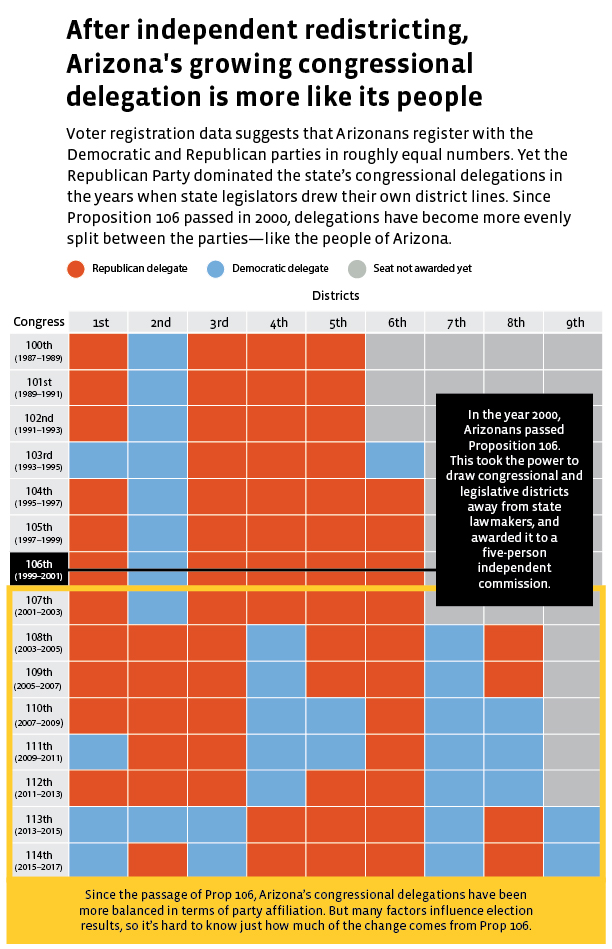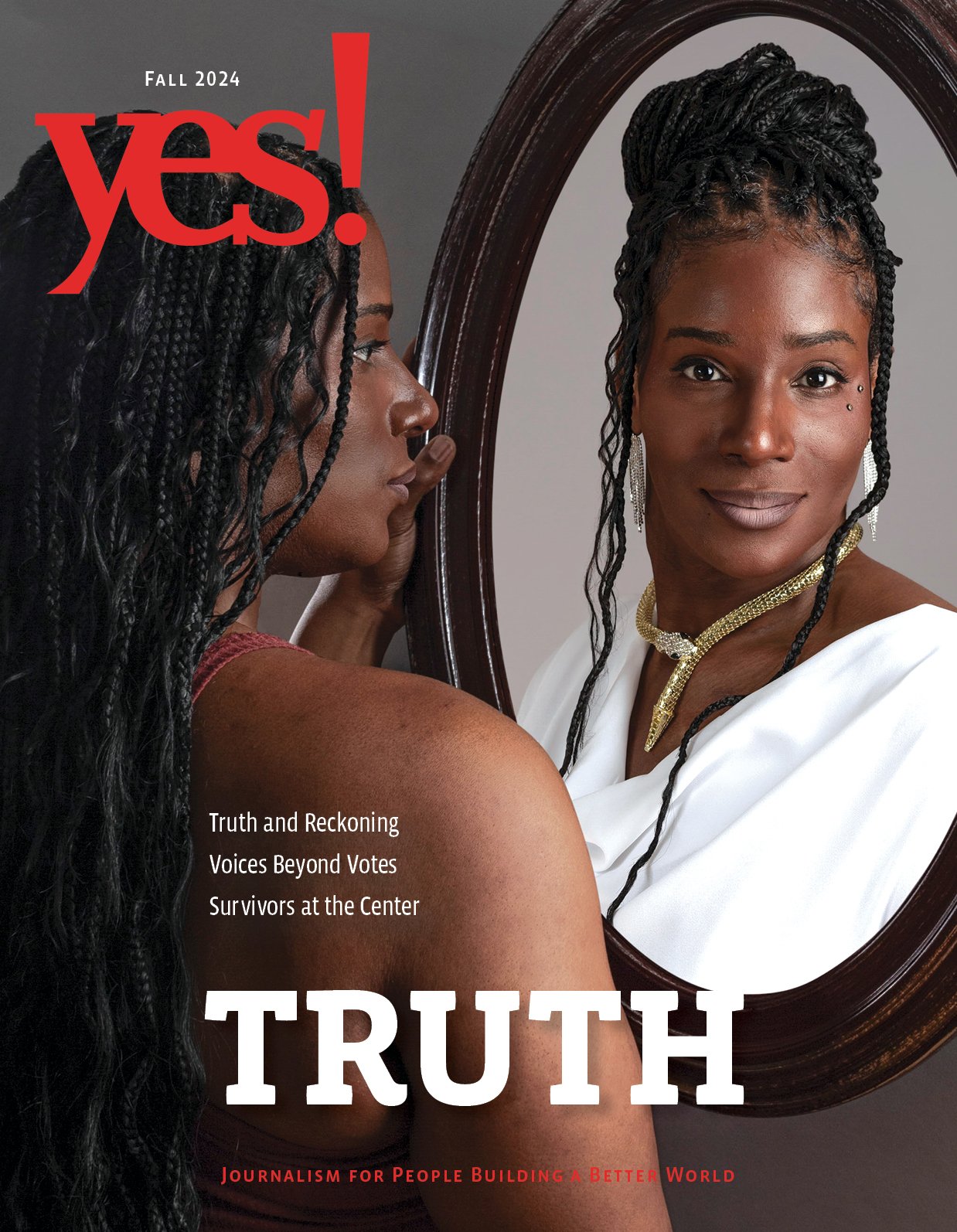Has Arizona Found a Solution to Gerrymandering?

YES! Illustration by Jennifer Luxton.
For most of her voting life, Arizona resident Serena Unrein has lived in non-competitive congressional districts. “They were either solidly Republican or solidly Democratic, so it was hard to feel like my vote really mattered in a congressional election,” she said. In 2005, she moved to congressional District 4, which is solidly Democratic with a large Hispanic population. Ed Pastor, the first Hispanic person elected to Congress in Arizona, was her representative.
“It was hard to feel like my vote really mattered in a congressional election.”
Then, in 2013, Pastor was redistricted to the 7th District, which contains most of inner Phoenix, while Unrein’s neighborhood ended up in the 9th District, which contains most of the city’s southern suburbs. Her new district leaned Republican, but wasn’t considered safe for either party.
“Living in a competitive district is exciting because it feels like my vote actually matters and I need to be paying attention to the candidates,” said Unrein.
Unrein noticed her neighbors were more engaged in congressional elections as well.
Signs for various candidates popped up on lawns. “People were more engaged and paying attention and had something to say about the race,” she said.
Unrein also feels that if she’s unhappy with her member of Congress, she has the opportunity to elect someone different. That didn’t really seem possible before—especially since congressional candidates in safe districts tend to hold onto their seats for as long as they want.
Those changes were the result of Proposition 106, a ballot measure that passed by a 12 percent margin in November 2000. The backers of the measure—including the League of Women Voters, the Arizona School Boards Association, and the nonprofit Common Cause—felt that legislators had no incentive to address the public’s concerns because they designed their districts themselves to make winning easy. Proposition 106 wrested authority to draw the state’s legislative and congressional district lines away from the Legislature and vested it in a five-person independent redistricting commission instead. The commissioners, who are selected through a complex process involving the courts and the political parties, include two Republicans, two Democrats, and one independent. They serve for 10-year terms and develop new districts after each decennial census.
“It seems like about every year the state legislators want to get rid of [Proposition 16] again.”
Sixteen years later, Arizona’s congressional delegation is far more competitive than it was in the years prior to independent redistricting. Throughout the ’90s, the state had six districts and Republicans almost always controlled a majority, but in recent years there’s been a considerable back and forth. That’s a big step toward reflecting the politics of the state’s residents, although it’s hard to know for sure if Proposition 106 caused the change. “It does seem that after the commission was instituted, you saw more fluctuation in which party dominated the delegation. But you can’t say definitively that the commission is the cause of that,” said Jerrick Adams, project director at Ballotpedia’s Public Policy Desk.

YES! Infographics by Jennifer Luxton.
Legislators who draw their own districts face intense criticism for using partisan gerrymandering to keep members of their own party in office, a process that undermines democratic accountability and leads to voter disenfranchisement. But that doesn’t mean that Arizona lawmakers took the change lying down. In fact, they’ve been fighting it in court for 16 years and don’t show any signs of slowing down. “It seems like about every year the state legislators want to get rid of it again,” said Gini McGirr, a long-time state board member of Arizona’s League of Women Voters, “so they’ll put out some bill to get rid of it or pick away at it in some way.”
One of those challenges reached the Supreme Court earlier this year. A group of Republican voters sued the commission for allegedly favoring the Democratic Party, but the court ruled 8-0 this April that the commission did not violate the principle of “one person, one vote.”
Prior to that, opponents unsuccessfully argued in court that independent redistricting is unconstitutional. Arizona’s Republican governor, Doug Ducey, has also limited the independent commission’s budget to an amount that is probably too small to cover its legal costs.
“Any time you have a process in which legislators are having such an important power stripped from them, they’re not going to give it up without a fight, and there’s not really a power more important to them than to draw their own districts and to rig elections in advance for themselves,” said Dan Vicuna, national redistricting coordinator at Common Cause. “They’re going to fight tooth and nail to defend that.”
Finding people to serve on a redistricting commission may become challenging due to the ceaseless lawsuits.
“I think what most normal people who aren’t deeply involved don’t appreciate is the toll that these constant lawsuits take,” said Andrew Gordon, a senior litigator at Coppersmith Schermer & Brockelman PLC. (Gordon represented Commissioner Linda McNulty in a variety of lawsuits related to the redistricting commission.) Lawsuits are easy for the legislators or governor’s office to file because it’s the taxpayers who foot the bill, he pointed out. And although the commissioners’ legal fees are paid for by taxpayers as well, Gordon says that finding people to serve on a redistricting commission may become challenging due to the ceaseless lawsuits. “It’s going to be hard to find people who are willing to spend 10 years and put up with that kind of stuff.”
Mixed results
Just because Arizona Republicans are embroiled in multiple legal battles to try to take back control of district mapping doesn’t mean that all proponents of independent redistricting are satisfied. One of the initiative’s original supporters was the Arizona School Board Association.
“In poll after poll, we have the voters saying that education is a top priority for them, and yet we had a legislator at that time, during the ’90s, that was very anti-education,” said Chris Thomas, ASBA’s general counsel and director of legal and policy services.
ASBA believed that the passage of Prop 106 would lead to more competitive elections, which would then lead to a legislature more in tune with what the people wanted and more supportive of education.
Although Thomas sees improvement in the competitiveness of Arizona congressional races, he says that the 30 legislative districts—which each select one state senator and two state representatives—have actually gotten worse. Thomas expected more support for traditional public schools and districts in the form of additional funding, and less support for vouchers, charter schools, and private schools. Yet today, only two states spend less per student on education than Arizona.
Prop 106 would lead to more competitive elections, which would then lead to a legislature more in tune with what the people wanted.
“Our hope was that if you create more competitive districts, that you’d come closer to having legislation that would mirror the wants of the general public as they’ve expressed them [in polls],” Thomas said. This would include more funding, a revenue base to support that, less support for alternative structures such as school vouchers, and more of an interest in improving the existing public education system.
This goes to show that just because legislators aren’t manipulating districts to protect incumbents or favor their party doesn’t mean that everyone else will be happy. Some voters believe that if districts aren’t competitive, that’s because the commission didn’t accomplish its goal. On the other hand, politically like-minded individuals and ethnic groups tend to live near one another, so competitive districts often look like the squiggly gerrymandered maps of old, rather than keeping specific communities, towns, or neighborhoods intact. Some people find this unfair as well.
It all depends on what’s meant by “fair,” said Michael Li, senior counsel for the Brennan Center For Justice’s Democracy Program. “Is it competitive elections or just districts that are neutrally drawn or drawn according to neutral principles [such as] following county boundaries or keeping communities together? Sometimes the goals people have, like keeping communities together or having competitive elections, are in conflict with one another.”

In Arizona, the redistricting commission is supposed to assure that districts are roughly equal in population, are compact and contiguous, respect communities of interest, incorporate geographical boundaries and features, and are in compliance with the U.S. Constitution and Voting Rights Act. That means they must not put ethnic and racial groups at a disadvantage. Only if there is no significant detriment to these goals may the commissioners try to maximize competitive elections.
“The more neutral the system is, the more it may be capturing that not many counties or parts of the state are necessarily typical of the demographics of the whole state, as far as partisan balance or economic balance or other things,” said Walter Olson, a senior fellow at the Cato Institute’s Center for Constitutional Studies, who was appointed by Republican Gov. Larry Hogan to serve as a co-chairman of Maryland’s Redistricting Reform Commission. “I’m not convinced that it somehow makes for an ideal legislature to pull everyone toward the middle. The legislature should probably have some strong voices from each side and then also a bunch of people in the middle. Part of the what we want out of this is not so much a specific type of representative, but also the assurance that specific types of motivation do not figure in.”
“I’m not convinced that it somehow makes for an ideal legislature to pull everyone toward the middle.”
It’s worth noting that it’s not always Republicans fighting against independent redistricting. “Maryland has one of the worst, probably the worst, gerrymander of any state, and it was done by a succession of Democratic governments and legislators,” said Olson. President Obama, whose rise to power in Illinois was likely the result of gerrymandering, nevertheless spoke out against it in his January State of the Union address to the applause of Democrats—who had lost control of the House in the midterms, and whose chances of getting it back have been hampered by the redistricting.
“Democrats in the chamber stood in response, while Speaker Paul Ryan (R-Wis.) and Republicans remained in their seats,” The Hill reported.
An idea that’s catching on
While Arizona’s independent redistricting commission is the nation’s first, it’s not necessarily the best. Because the state is quite polarized, the power largely rests with just one independent commissioner who has, so far, sided either with the commission’s two Republicans or two Democrats. In 2011, then-Arizona Gov. Jan Brewer, a Republican, removed independent Chairwoman Colleen Mathis from the commission. The removal was overturned.
Fully 13 states either already have some sort of independent redistricting, or are looking into it.
California took a different tack when voters there approved a ballot measure in 2010 that shifted redistricting authority for congressional seats to an independent commission. That commission consists of five Democrats, five Republicans, and four people who belong to neither party. At least three Republicans, three Democrats, and three people belonging to neither party must vote for a redistricting plan in order for it to pass, fostering increased cooperation.
And California’s commission is forbidden from taking any electoral results, including competitiveness, into account. But the Brennan Center’s Michael Li says that the natural-looking, less gerrymandered districts it drew ended up being more competitive anyway.
The idea of not having legislators draw their own districts is catching on elsewhere too. Thirteen states either already have some sort of independent redistricting or are looking into it.
Those efforts could well lead to decades of litigation. But it still seems fairer than redistricting by legislators, which has often turned into an incumbent jobs program, rather than a reflection—however imperfect—of the will of the people.






